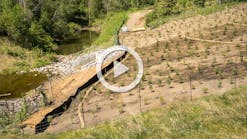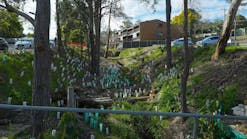Editor’s note: This article first appeared in the September/October 2015 issue of Erosion Control.
Increased traffic brought the need for bridge expansion and widening of Florida’s State Road 415 from two lanes to four. The completed project is located just north of Sanford.
Associated Construction Products (ACP) of Lutz, FL, teamed up with Strata Systems of Cumming, GA, to combine technical expertise and the right geogrid product for this project. The main part of the project involved stabilizing very steep embankments on both sides of a 1.84-mile stretch of the road and a multiuse path on the right side of the road. A secondary part of the project involved stabilization of a slope on a temporary detour, which was nearby on State Road 46.
Editor's note: This article first appeared in the September/October 2015 issue of Erosion Control. Increased traffic brought the need for bridge expansion and widening of Florida’s State Road 415 from two lanes to four. The completed project is located just north of Sanford. Associated Construction Products (ACP) of Lutz, FL, teamed up with Strata Systems of Cumming, GA, to combine technical expertise and the right geogrid product for this project. The main part of the project involved stabilizing very steep embankments on both sides of a 1.84-mile stretch of the road and a multiuse path on the right side of the road. A secondary part of the project involved stabilization of a slope on a temporary detour, which was nearby on State Road 46. [text_ad] Finished in 2014, the project took “about a year and a quarter,” says Randy Friloux, P.E., vice president with ACP. “We used a lot of erosion control measures, a lot of reinforced soil, because there were a lot of 1-to-1 slopes.” The steep slopes and compressible soils caused concern that the road might, sometime in the future, shift and even crack if precast concrete panel retaining walls were used. Florida Department of Transportation (FDOT) officials suggested that 1:1 slope reinforcement with geogrid be used instead.Finished in 2014, the project took “about a year and a quarter,” says Randy Friloux, P.E., vice president with ACP. “We used a lot of erosion control measures, a lot of reinforced soil, because there were a lot of 1-to-1 slopes.”
The steep slopes and compressible soils caused concern that the road might, sometime in the future, shift and even crack if precast concrete panel retaining walls were used. Florida Department of Transportation (FDOT) officials suggested that 1:1 slope reinforcement with geogrid be used instead.
The Strata Microgrid served as intermediate reinforcement and was placed on 1-foot vertical spacing for the local surficial stability of the 1:1 slope.
Strata geogrid was also installed to stabilize the 1:1 slope of the temporary detour on State Road 46, about a mile in length. This slope’s surface was covered with a synthetic erosion blanket, North American Green C350. Then native Bahia grass sod was laid on top of it.
“Bahia sod is very durable, very hardy. It stands up to drought. The roots dig in and intermingle into the erosion control blanket,” says Friloux.
The project was the largest geogrid slope project in the state of Florida. Total slopes and anchor trench areas measured 300,000 square feet.
Porter Canal
“We had a lot of incidental rain storms and washouts. The weather affected things,” says Friloux.
A surprising aspect of the project to Friloux was “the craftsmanship, which we developed quickly. All of the slope faces were cut by hand to create a uniform slope angle. It was all handiwork.”
He adds, “It took some real craftsmanship, but our guys caught on to it soon. They used hand shovels, cutting the slope face just right.”
These days the entire project “looks fantastic,” says Friloux. And as for geogrids made by Strata, “we use them quite a bit. They offer good technical support.”
Expanding an Airport
Rocky Mountain Metropolitan Airport is situated in Broomfield, CO, between Denver and Boulder. With proximity to these cities the airport has grown quickly and attracted more traffic, especially larger business commuter jets.
To accommodate this type of aircraft meant increasing the length of the runway to meet Federal Aviation Administration (FAA) safety requirements. The FAA paid for the $8 million project that extended the runway 600 feet wide by 1,000 feet long.
Most of the project was done during 2013. Work was shut down in December of that year, resumed in early 2014, and finished that March.
For slope stabilization, Ken Kinnard, manager at Bowman Construction Supply in Denver, recommended GW30V4 Geoweb from Presto Geosystems of
Appleton, WI. “We’ve been using Presto Geo for 10 years,” says Kinnard, adding that he appreciates the always-available engineering support from the manufacturer.
The biggest challenge to the runway extension project was “building a 54-foot-tall retaining wall that is 600 feet long,” he says.
The Geoweb was “used as a veneer, laid on a 1-to-1 slope that was covered in native vegetation—mostly grasses—all the way top to bottom.” It was fastened with Presto’s ATRA Key connection system. “It works like a cufflink,” says Kinnard.
Unlike products that require “pulling pins together with a pneumatic box stapler, Presto Geo’s system is unique in its ease of application,” he explains. ATRA Key connects sections of Geoweb much more quickly than conventional stapling. One person can do the connecting instead of the two needed for stapling, saving time and labor costs. ATRA Key is also safer for workers to use, as there is no chance of accidentally being hit with a staple.
The GW30V4 Geoweb was chosen “for its medium-weight depth, cost-effectiveness, and ability to hold topsoil on steep slopes and allow vegetation to grow very quickly,” says Kinnard.
The GW30V4 comes in sections that measure 8.5 by 27 feet. Two hundred thirty-seven square feet were used on the project.







